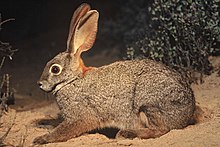This article needs additional citations for verification. (January 2018) |
| Riverine rabbit[1] | |
|---|---|

| |
| Scientific classification | |
| Domain: | Eukaryota |
| Kingdom: | Animalia |
| Phylum: | Chordata |
| Class: | Mammalia |
| Order: | Lagomorpha |
| Family: | Leporidae |
| Genus: | Bunolagus Thomas, 1929 |
| Species: | B. monticularis
|
| Binomial name | |
| Bunolagus monticularis (Thomas, 1903)
| |

| |
| IUCN distribution of the Riverine rabbit
Extant (resident)
| |

| |
The riverine rabbit (Bunolagus monticularis), also known as the bushman rabbit or bushman hare, is a rabbit with an extremely limited distribution area, found only in the central and southern regions of the Karoo Desert of South Africa's Northern Cape Province. It is the only member of the genus Bunolagus because of unique traits that separate it from the other leporids. It is one of the most endangered mammals in the world, with only around 500 living adults, and 1500 overall.
They have a diet which consists of mostly plants and vegetation, but their usual food sources are being diminished, causing a scarcity for their population. This food loss is also connected to other problems such as with forming burrows. A unique aspect of its biology is that females can only produce one offspring per year. This contributes to how it is classified as critically endangered, which is the most severe classification available. Other unique traits include being nocturnal, and producing two different types of droppings. Currently, there are conservation plans being enacted to help with its decreasing population and habitat.
- ^ Hoffman, R.S.; Smith, A.T. (2005). "Order Lagomorpha". In Wilson, D.E.; Reeder, D.M (eds.). Mammal Species of the World: A Taxonomic and Geographic Reference (3rd ed.). Johns Hopkins University Press. p. 194. ISBN 978-0-8018-8221-0. OCLC 62265494.
- ^ Collins, K.; Bragg, C.; Birss, C. (2019). "Bunolagus monticularis". IUCN Red List of Threatened Species. 2019: e.T3326A45176532. doi:10.2305/IUCN.UK.2019-1.RLTS.T3326A45176532.en. Retrieved 11 November 2021.
